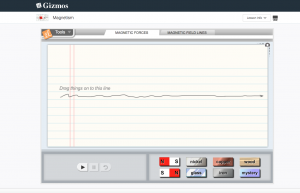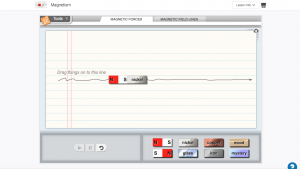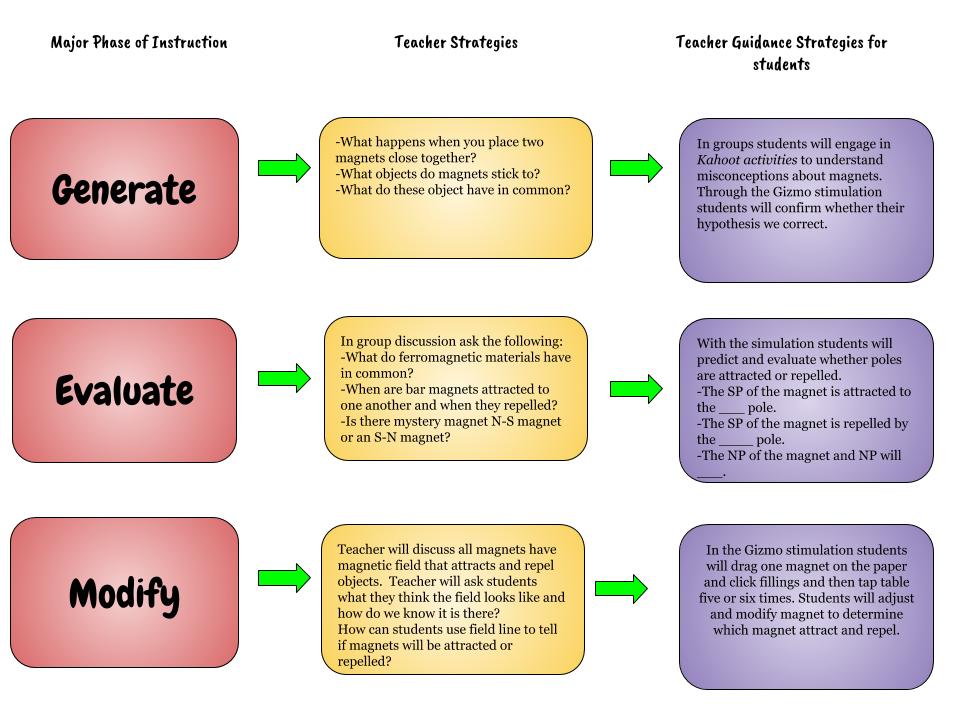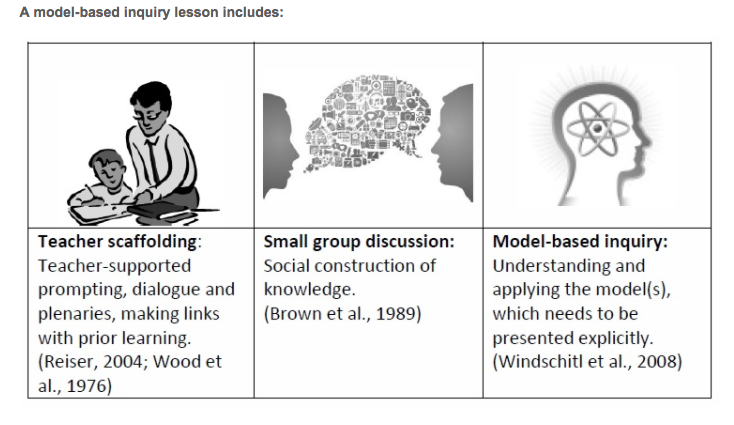I found the teacher quote in Khan, S. (2007) Model-based inquiries in chemistry article resonated with me.
“I want [students] to learn chemistry, [but] I don’t want them to just understand the concepts–I want them to understand where to get the concepts and where they come from” (p. 881).
This teacher is facilitating metacognition through inquiry, this allows for students mental models to be enriched and revised. Khan (2007) argues the aim of model-based teaching is to develop teaching strategies that foster learning environments that build, extend, elaborate and improve mental models of the way of the world works. Model-based inquiry lesson, as seen below, facilitates the critical evaluation, but lends to opportunities where students challenge misconceptions.
One of my favourite units to teach is Grade 2 Magnets and other magnets because most students have some prior knowledge how a magnet works and the authentic learning that takes place with hands-on learning.
Describe the interaction of magnets with other magnets and with common materials.
Students will:
- Determine which materials are attracted to a bar magnet.
- Define the term “ferromagnetic.”
- Observe the interaction of bar magnets.
- Determine that like poles repel and opposite poles attract.
- Understand that magnets exert force at a distance.
- Observe magnetic field lines for attracting and repelling magnets.
- Use magnetic field lines to predict if an object will be attracted to a magnet or repel
My School Division has access to Gizmos that are interactive online simulations for math and science education in grades 3 – 12, through our Moodle Portal. Through the simulations, students will drag bar magnets and a variety of other objects onto a piece of paper. Clicking play will release the objects to see if they are attracted together, repelled apart, or unaffected. Students will be able to sprinkle iron filings over the magnets and other objects to view the magnetic field lines that are produced.



Khan, S. (2007). Model-based inquiries in chemistry. Science Education, 91(6), 877-905.

Hi Mary,
In your framework, I think your teacher questions are well planned and will push students’ thinking about the topic. The technology you have chosen, Gizmo and Kahoot, will keep most students motivated, allow you to gather formative assessment as well as enable students to explore the content through an online platform.
I am curious, what type of summative assessment would you have your students do after they have gone through the GEM cycle to show them how this knowledge transfers to real life. How could they apply this knowledge authentically to a real like situation? We have similar outcomes about magnets in NB, and one thing we struggle with is the “So what?” and making the unit less thematic and more applicable to solving real-life problems.
Cheers,
Sarah
Hi Mary!
I am super interested in your use of Gizmos! I have explored them a little bit this year but haven’t been sure about them. Have you and your kids enjoyed learning with them?
What potential do they afford classrooms that we don’t already have?
Ally
Hello Allison,
We are lucky my school division has access to these Gizmos! They mostly used to be embedded into a Moodle course. As sometimes, access to the materials can be expensive and the simulations are a good option. As we learned in the Jasper Project, there are many affordances with when learning occurs in video format, therefore these videos are very engaging and lend to deeper understanding.
As an elementary teacher, I find it difficult to find separate simulation videos sites or programs. In saying that, I do find Mathletics does incorporate simulations into their program.
Cheers,
Mary
Hello Sarah,
Thanks for your feedback! Sorry, I should have clarified, this T-Gem is not the whole unit on magnetism. In fact, the unit ends with students building a magnetic toy, either with makerspace materials or with Lego. There is a rubric for this final project that ensures all concepts are covered. Always, a great summative project-based assignment.
~Mary
Hi Mary
I like the fact that your teacher strategies are well planned out ahead of time.
I wonder if Kahoot is the best tool to determine the students’ comprehension. It seems this tool is a race to get the correct answers…and I know when I was a participant I would sometimes guess.
A good next step might be to have your students put their results/findings/journal entries into an envelope to be opened after they cover the same topic later in high school.
Christopher
Hey Mary,
You picked a great concept to cover. I was just having my class create electromagnets last week, and the misconceptions kids were sharing with their groups were wild. Many kids were loudly proclaiming how the iron nail was electrified as electricity ‘jumped’ through the wire’s insulation.
At that point I had to stop the lesson and have a conversation with the class.
I really like your closing explanation of a magnetic field, and having students think about what it could look like. This invisible field is often too abstract for younger students to picture. The lessons builds well to that point.
Hello Mary,
I was really intrigued by your planning and layout. I’ve never used Gizmos but I plan on looking into it for my school. You mention the fact that most kids have prior experience with magnets through “hands on learning.” I’m curious if you feel the simulation offers added benefits to the students after using real magnets and whether you think the authentic learning first plays a large role in the successful learning of concepts by the student?